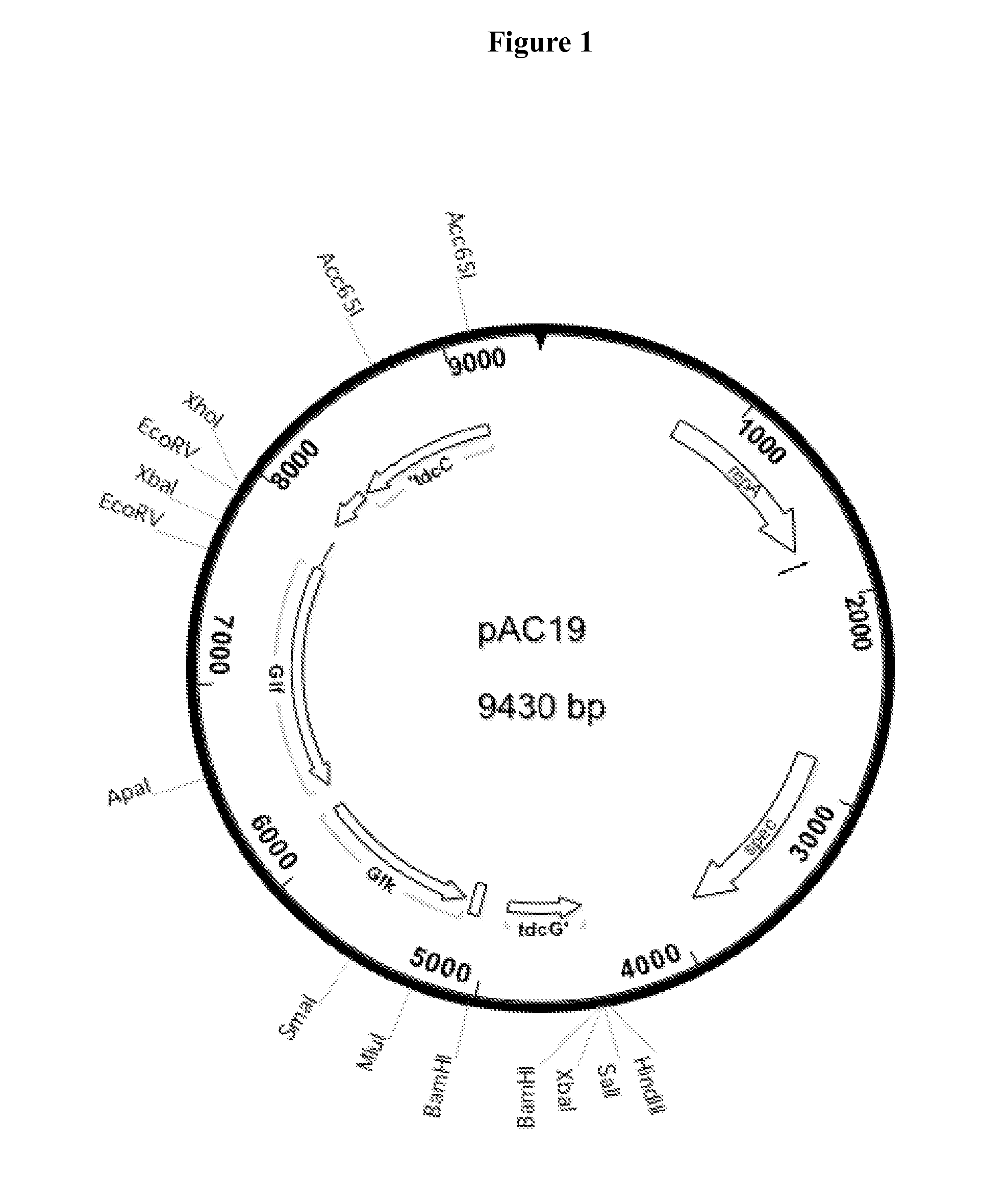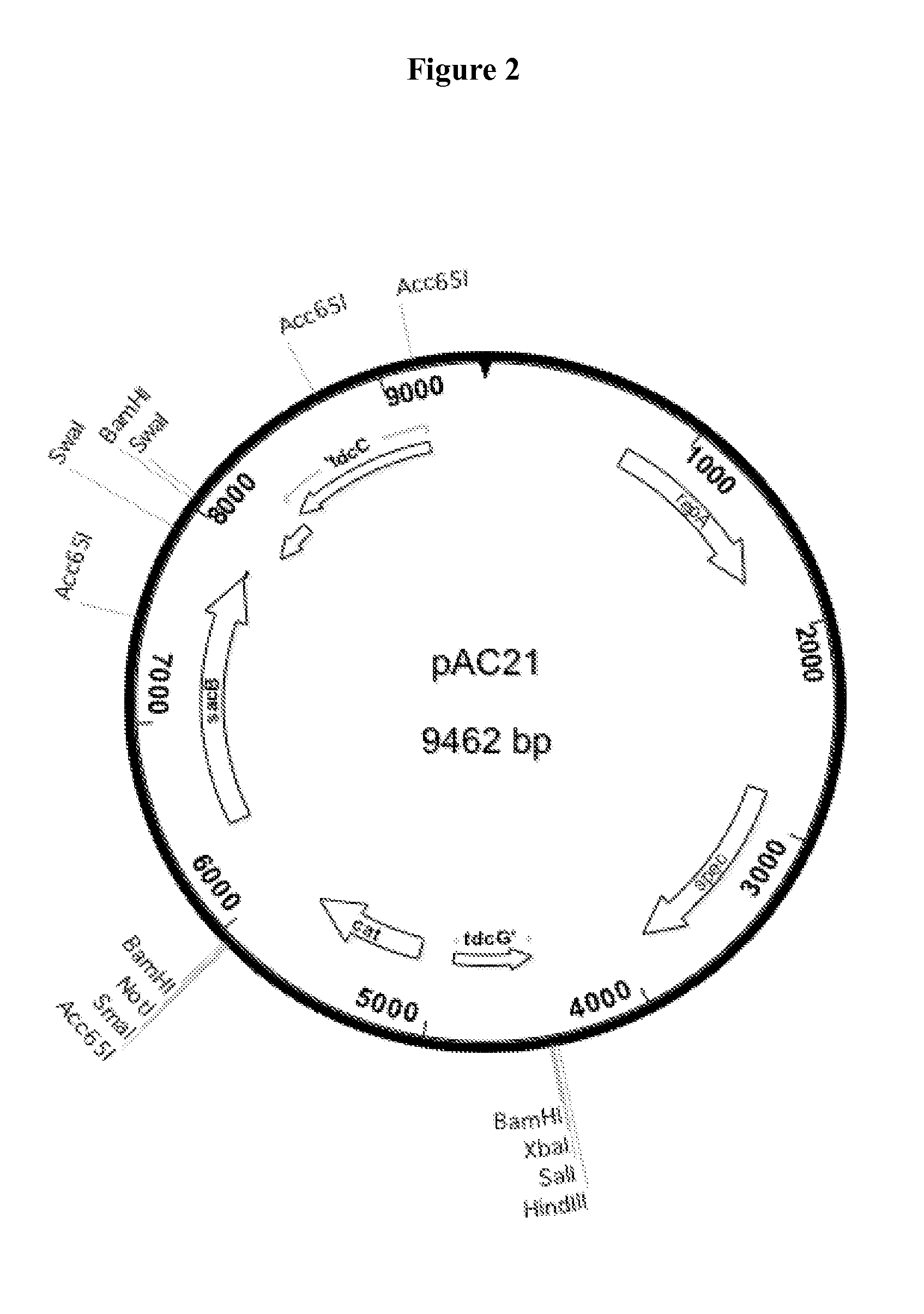Method of producing succinic acid and other chemiclas using facilitated diffusion for sugar import
a technology of facilitated diffusion and succinic acid, which is applied in the direction of bacteria peptides, biofuels, peptide sources, etc., can solve the problems of poor efficiency of atp production from sugars such as glucose, severe limitations of 030 to use glf, and inability to show that the facilitated diffusion system could support anaerobic growth, etc., to achieve the effect of improving fermentation performance parameters, facilitating diffusion, and improving the balance of facilitated diffusion
- Summary
- Abstract
- Description
- Claims
- Application Information
AI Technical Summary
Benefits of technology
Problems solved by technology
Method used
Image
Examples
example 1
Construction of AC15, a Derivative of KJ122 that Contains the Glf and Glk Genes from Gene Cluster from Zymomonas mobilis CP4
[0074]All manipulations of DNA and plasmids, polymerase chain reaction (PCR), transformation, and chromosomal integration were accomplished by standard methods that are well known in the art, It is well known that DNA sequences can be cloned and joined together to form new combinations that cannot be easily found in nature. In addition to the more traditional methods involving restriction enzymes and DNA ligase, newer methods using recombineering in yeast, the so-called “Gibson Method” of in vitro splicing of DNA, or any other appropriate method can be used to construct such novel DNA sequences. The DNA fragments needed can be obtained from libraries of clones or by PCR from appropriate template DNA. It is also understood that many desired DNA sequences can be designed and synthesized from chemical precursors. Such a service is supplied by a number of commercia...
example 2
Strain AC15 Produces Succinate as Well as Parent KJ122
[0079]Strains KJ122 and AC15 were grown under microaerobic condition in 7 liter fermentors (New Brunswick Scientific) at 39° C. using a minimal medium with glucose fed batch system. The starting volume of 3 liters contained potassium phosphate monobasic (18 mM), magnesium sulfate (2 mM), betaine (1.33 mM), trace elements, Antifoam 204 (8 ppm) and 25 g / l glucose. The pH was adjusted initially to pH 7.0 and thereafter was maintained at pH 6.5 as acid was produced by addition of the ammonium hydroxide / ammonium bicarbonate solution described below. The 150 ml inocula were grown aerobically and contained a minimal medium similar to the above described medium, except that glucose was at 20 g / l and calcium chloride was added to a final concentration of 0.1 mM. Agitation was set at 750 RPM (revolutions per minute). When glucose decreased to 5 g / l, a 650 g / l glucose feed was started and maintained at a rate aimed to keep the glucose conce...
example 3
Spontaneous “Red Mutants” Derived from AC15
[0080]KJ122 is able to ferment lactose, as evidenced by formation of red colonies on MacConkey lactose plates (Beckton-Dickinson, Franklin Lakes, N.J.). However, AC15 does not ferment lactose, as evidence by producing “white” (beige) colonies on MacConkey lactose plates. This white colony phenotype of AC15 results from binding and inhibition of lactose permease (LacY) by unphosphorylated EIIAGlc protein. This white colony phenotype is present in all strains deleted for ptsHI, since the enzymes required to phosphorylate EIIAGlc are absent, and as a result, all EIIAGlc present in the cells remains unphosphorylated. Thus, ironically, E. coli ptsHI mutants are phenotypically Lac−, even though lactose is not imported by the PTS system in E. coli.
[0081]The inventors noticed by chance that when MacConkey lactose plates were streaked with AC15 and allowed to incubate overnight at 37° C., and then for an extra day at room temperature (about 22° C.)...
PUM
| Property | Measurement | Unit |
|---|---|---|
| Mass | aaaaa | aaaaa |
| Mass | aaaaa | aaaaa |
| Density | aaaaa | aaaaa |
Abstract
Description
Claims
Application Information
 Login to View More
Login to View More - R&D
- Intellectual Property
- Life Sciences
- Materials
- Tech Scout
- Unparalleled Data Quality
- Higher Quality Content
- 60% Fewer Hallucinations
Browse by: Latest US Patents, China's latest patents, Technical Efficacy Thesaurus, Application Domain, Technology Topic, Popular Technical Reports.
© 2025 PatSnap. All rights reserved.Legal|Privacy policy|Modern Slavery Act Transparency Statement|Sitemap|About US| Contact US: help@patsnap.com



